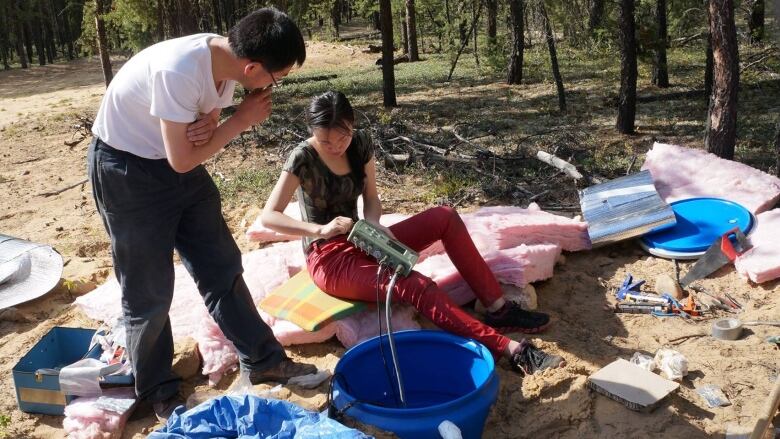More frequent, stronger earthquakes linked to fracking, Alberta study finds
Alberta's strongest fracking-related tremor was a magnitude 4.8 earthquake near Fox Creek in 2016

Earthquakes caused by hydraulic fracturing in Western Canada are becoming stronger and more frequent, according to a study from the University of Alberta.
From December 2013 to February 2016, researchersdetected 250 seismic eventswithin 100 kilometres of Fox Creek,Alta., that measured greater than 2.5 on the Richter Scale.
During a three-year periodfrom 2010 to 2013, they recorded fewer than 10 seismic events in the same region.
"Since December 2013, there has been a pronounced increase in the rate of seismicity in the Fox Creekregion related to nearby hydraulic fracturing," the research paper concludes.
- Frackingand earthquakes: Exploring the connection
- Alberta researchers sayfrackingtriggered earthquakes near Fox Creek
Hydraulic fracturing is a process in which liquid is pumped thousands of metres underground with enough pressure to cause rock formations to split, making natural gas extraction more efficient.
"Hydraulic fracturing isdesignedto cause small earthquakes," saidRuijiaWang, one of the study'sco-authors anda PhD candidate at the U of A.
"This is how they create fracturesto let the gas flow back. But normally we wouldn't call these earthquakes, because they're below magnitude zero so they won't be felt and they can hardly be detected."

Tremors usually aren't felt until they measure higher than magnitude 4.0 on the Richter Scale, Wang said. Damage is unlikely unless an earthquake measures 5.0 or higher on the same scale.
"Those are the earthquakes that we might want to control and monitor," Wang said.
Red light, green light
Alberta's strongest fracking-related tremor in the past decade was a magnitude 4.8earthquake near Fox Creek in January 2016.
The town's mayor, Jim Ahn, said that one felt like a truck driving by.
"It was just alow vibration and it lasted three seconds," he said.
The Alberta Energy Regulator has detected more than 250 earthquakes triggered by hydraulic fracturing near Fox Creek since December 2013.
Ahn said he's not aware of any damage or injuries caused by fracking-related earthquakes in the town of about 2,000people.
"We don't know how damaging it is in the long run, but we know that right now, presently, there's no damage and everything's working," he said.
A fracking operation, owned by Repsol Oil & Gas, was shut down while the AER investigated the January 2016 earthquake near Fox Creek.
Energy companies that use hydraulic fracturing in Alberta are subject to an AER regulation colloquially known as the "traffic light protocol."
Companies have a green light for operations that cause quakes lower than magnitude 2.0, while tremors that measure between 2.0 and 4.0 are cautioned with a yellow light.
If a fracking-relatedearthquake spikes into red light territory, measuringhigher than magnitude 4.0, the operation is required to shut down immediately.
'Things are still under control'
The AER started to research frackingfive years ago.
"It's quite important to basically be able to discern which [fracking operations]are seismogenic and which ones aren't," said Ryan Schultz, an AER seismologist and lead author of the U of Astudy.
"If we can quantify that, then we can regulate more responsibly, because then you can pick out which wells would and wouldn't cause [earthquakes]."
Less than half of oneper cent of Alberta's hydraulic fracturing operations are associated with earthquakes, Schultz said.
Wang said she hopes the paper contributes to an emerging field of study, to help refine AERregulations governing hydraulic fracturing.
"The majority of the hydraulic fracturing wells aren't causing earthquakes, so I won't go that far to say we should stop everything just to avoid them happening," Wang said.
"To date, they are doing a good job, to me, because there's no damage and things are still under control. They're barely reaching magnitude 4."
'It's a very expensive operation'
Calgary-based Questerre Energy and many other companies follow their own fracking rules to prevent unintended and often costly consequences.

"When you hydraulically fracture a well, you're trying to achieve the best possible outcome," said KeithWilford, an engineering and operations consultant withQuesterreEnergy.
"In other words, spend the least amount of money to get the most amount of economic return."
The total cost to drill, complete and hydraulic fracture a single deep well in Alberta could cost up to $15 million, Wilford said. In order not to waste money, thecompany reviews pumping procedures, pressures and flow ratesbefore beginning a fracture.
"It's a very expensive operation that we run," Wilfordsaid."It's only a small amount,incrementally,to do a very good jobversus not doing a good job, so virtually there's no benefit to not doing a good job."
Wilfordsaid he has not been involved in a fracking operation that caused an earthquake. He said Questerre does not drill near Fox Creek.












_(720p).jpg)


 OFFICIAL HD MUSIC VIDEO.jpg)
.jpg)



























































































